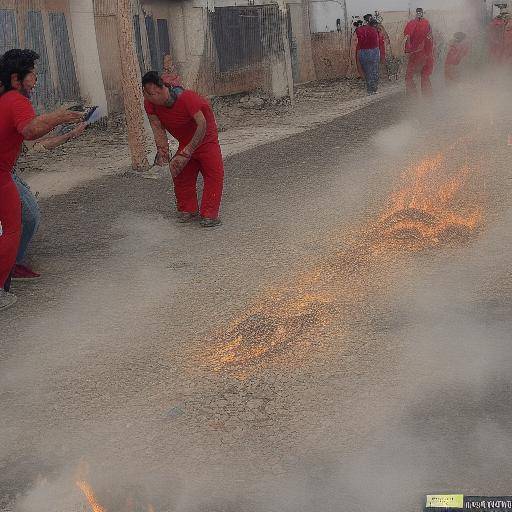
In the search for ancestral knowledge and understanding of the world in constant change, dreams and visions have played a significant role in the rites of initiation. We will explore the historical wealth, the current profound relevance and benefits of these elements in the different cultural contexts.
Introduction
The rites of initiation, present in cultures around the world, are fundamental processes for individual development and social cohesion. Within these rituals, dreams and visions occupy a prominent place, providing guidance, wisdom and connection with the sacred. Throughout this article, we will explore the transcendence of dreams and visions in the rites of initiation, examining their impact, historical evolution, and their importance in contemporary society.
History and Background
Dreams and visions during the rites of initiation have been a constant throughout the history of humanity. From ancient civilizations to indigenous cultures, these phenomena have been regarded as carriers of divine messages, personal revelations and connections with the spiritual world. Even in the modern world, these practices maintain their relevance in spiritual communities and movements.
- Exploration of ancient civilizations: Historical records reveal the presence and relevance of dreams and visions in the traditions of ancient civilizations. Cultures such as Egyptian, Greek, and Mesopotamian attached great importance to dreams as vehicles of communication with the gods and the understanding of destiny.
- Evolution through indigenous cultures: Indigenous cultures of different continents continue to consider dreams and visions as an indispensable part of the initiation rituals. These processes are fundamental to receiving spiritual guidance, finding purpose and taking roles within the community.
- Impact on contemporary society: Although modern society has experienced major transformations, the importance of dreams and visions in the rites of initiation persists in various fields, including shamanic practices, spiritual movements and alternative therapies.
Deep analysis
The relevance of dreams and visions in the rites of initiation is due to their ability to offer understanding, emotional strength and a deep connection with the transcendent. These phenomena provide clarity and direction at key moments of life, marking significant transitions and facilitating individual and collective integration.
- Benefits and challenges of interpretation of dreams: Dreams offer multiple benefits, such as self-knowledge, resolution of internal conflicts and acquisition of personal revelations. However, they also pose challenges, such as precise interpretation and the connection between symbolic elements and their emotional significance.
- Visions as transformation catalysts: Visions, like dreams, play a crucial role in the rites of initiation by providing glimpses of alternative realities, revealing latent potentialities and configuring new horizons of understanding.
- Current trends and contemporary challenges: In modern society, interest in dreams and visions in initiation rites has been revitalized, driven by the search for meaning, emotional and spiritual well-being. However, the interpretation of these phenomena in a current context poses challenges, such as the validity of analysis methodologies and the integration of these practices into urban and technological environments.
Exhaustive examination
The application of dreams and visions in the rites of initiation manifests in multiple ways, adapting to the needs and beliefs of different cultures. This diversity in its use reflects the wealth and complexity of these elements as sources of wisdom and tools for spiritual growth.
- Contemporary applications in initiation rituals: At present, communities and spiritual movements seek to integrate dreams and visions into the rites of initiation as means of granting purpose, giving direction and fostering authenticity in the individual.
- Best practices and recommendations: The integration of dreams and visions into the rites of initiation benefits from following best practices, such as the accompaniment by experienced guides, the creation of enabling environments for the introspection and consideration of the diversity of interpretations and meanings within a broad cultural context.
- Disaggregation of perspectives and expert opinions: Experts in psychology, anthropology and spirituality provide various perspectives on the usefulness, interpretation and impact of dreams and visions on the rites of initiation, enriching the understanding of these phenomena from different approaches.
Comparative analysis
Dreams, visions and rites of initiation share common aspects and intertwine in significant ways, revealing similarities, differences and possible synergies.
- Similarities and Differences between Dreams and Visions: Both phenomena represent manifestations of the unconscious, however, dreams usually occur during sleep, while visions can manifest during states of meditation, trance or mystical experiences.
- Intersection between visions and initiation rites: Visions can play a leading role in the rites of initiation, guiding the individual in the understanding of his purpose, the connection with the sacred and the transcendence of his existence, becoming transformative experiences.
Practical Tips and Accessible Tips
Integrating dreams and visions consciously into initiation rites can benefit from practical guidance and actionable advice to maximize their impact.
Practical Tips:
- Establish safe and conducive spaces for the reception of dreams and visions.
- Promote the incorporation of introspection, meditation and connection with nature as preparation for initiation rites.
- Provide tools for conscious and respectful interpretation of the dream and visionary elements.
Accessible Tips:
- Establish an intimate connection with ancestral traditions: Learning from indigenous and ancestral traditions can provide a deeper understanding of dreams, visions and rites of initiation.
- Find expert guidance and spiritual guides: Having expert guidance in the interpretation of dreams and visions can enrich the experience of initiation rites.
- Promoting conscious integration of learning: At the end of the rites of initiation, it is important to foster the conscious integration of the revelations received through dreams and visions in everyday life.
Industry Perspectives and Expert Reviews
The perspectives of industry and the opinions of experts provide an informed view of the relevance and future of dreams and visions in the rites of initiation.
- Interviews with Spiritual Leaders: Leaders from various spiritual traditions offer their perspective on the importance of dreams and visions in the rites of initiation, as well as their projections on their relevance in the future.
- Analysis of emerging trends: The integration of dreams and visions into the rites of initiation is constantly evolving, adapting to contemporary needs and understandings, which represents an emerging trend that deserves to be contextualized.
Cases of Study and Applications in Real Life
Cases of study and applications in real life illustrate the significant influence of dreams and visions on initiation rites in different circumstances and environments.
- Examples of contemporary cultures: Contemporary communities around the world, from African tribes to Western urban communities, have integrated dreams and visions into their rites of initiation, demonstrating the continuity and adaptability of these practices through time and space.
- Impact on communities and organizations: The conscious incorporation of dreams and visions into the rites of initiation has led to significant results at the individual and community level, providing direction, healing and a sense of belonging to those involved in these processes.
Future Trends and Predictions
The future of dreams, visions and rites of initiation is seen as a scenario in which these practices will maintain their relevance and adapt to the needs of future generations.
- Emergency of integration practices: Conscious integration of dreams and visions in initiation rites is expected to continue to evolve as traditional spiritual practices dialogue with modern psychological and scientific approaches.
- The Role of Technology and Connectivity: Technology and global interconnection provide opportunities for diffusion and connection between different initiation practices, promoting intercultural dialogue and mutual learning about dreams and visions.
Conclusions and FAQs
Conclusions
Dreams and visions are fundamental pillars in the rites of initiation. From ancient times to the contemporary era, its relevance has transcended cultures and eras, influencing the formation of individual and collective identities. Their conscious incorporation into the rites of initiation can provide understanding, meaning and connection with the transcendent, enriching the lives of those who embark on this journey.
Frequently asked questions
**1. Do dreams and visions have the same meaning in all cultures?**While there are universal elements in the interpretation of dreams and visions, their meaning can vary significantly according to cultural beliefs and personal experiences.
**2. What is the difference between a dream and a vision in the context of initiation rites?**Dreams usually occur during sleep, while visions can manifest during meditation, trance or mystical experiences. Both can offer significant revelations in the context of initiation rites.
**3. How can I interpret a dream or vision in the context of an initiation rite?**The interpretation of dreams and visions requires sensitivity, self-knowledge and, in some cases, the orientation of experienced spiritual guides that can provide comprehensive contexts and symbolic meanings relevant to the individual and his culture.
**4. Do contemporary traditions also incorporate dreams and visions into their rites of initiation?**Yes, many contemporary communities and spiritual movements have revitalized the use of dreams and visions in their initiation rites, recognizing their potential for personal understanding and community strengthening.
**5. What benefits can dreams and visions bring in a rite of initiation?**Dreams and visions can offer guidance, clarity and connection to the sacred, facilitating personal transformation and integration within the community.
**6. What is the future of dreams, visions and rites of initiation in a technological and globalized world?**Despite the challenges and opportunities posed by the modern era, it is hoped that dreams, visions and rites of initiation will continue to evolve, adapting to the needs of the contemporary world and maintaining its transcendental meaning.
In conclusion, the importance of dreams and visions in the rites of initiation crosses cultural and temporal borders, manifesting itself as sources of ancestral wisdom and significant guides on the path to self-realization and integration into society. Their conscious and respectful integration into the rites of initiation can greatly contribute to the individual and community well-being, providing a deep connection with the transcendent and the personal realization.
Through the exploration of its history, contemporary application, benefits, challenges and future projections, the profound relevance of dreams and visions in the rites of initiation is revealed, encouraging greater reflection and understanding of these fundamental elements in the search for spiritual growth and social cohesion.









